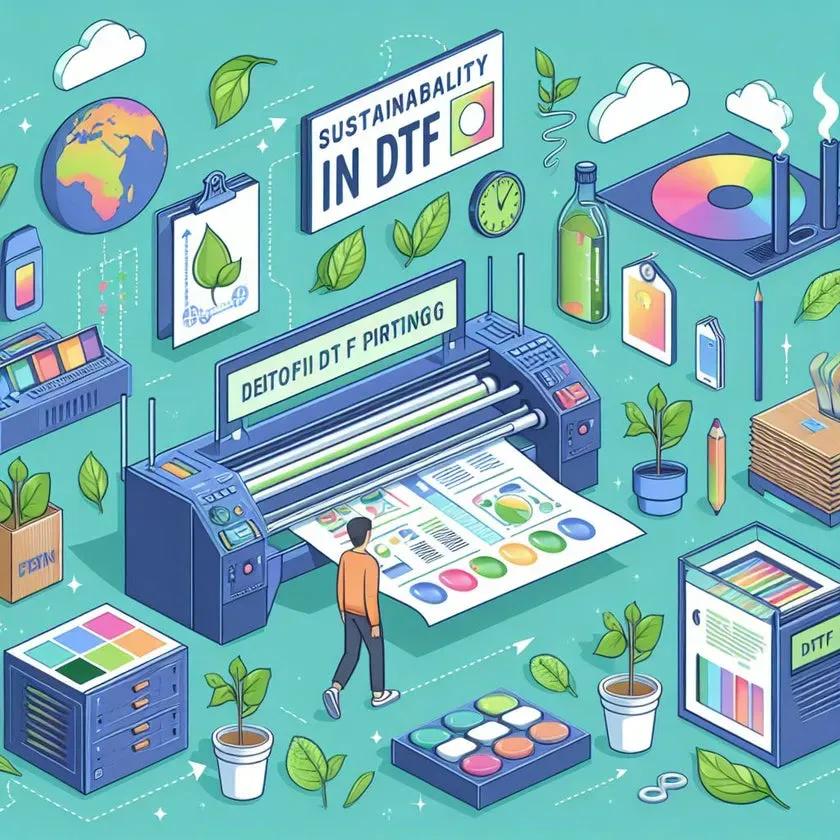DTF printing environmental footprint is a topic reshaping how brands design and manufacture apparel as fast fashion pressures grow. From inks to energy use, every choice in the DTF workflow affects the environmental impact of textile printing. This introductory look highlights practical strategies for achieving DTF printing sustainability, including eco-friendly textile printing, DTF ink waste reduction, and DTF film recycling. By evaluating materials, energy intensity, and waste streams, businesses can lower costs while improving worker safety and community impact. If companies pursue low-toxicity inks and efficient curing, they can maintain vibrant results without compromising profitability or environmental responsibility.
A broader view reframes the topic in terms of digital transfer printing on textiles and related garment-decoration technologies. This framing aligns with eco-friendly textile printing, sustainable ink management, and lifecycle considerations for fabric transfers. By exploring energy efficiency, material stewardship, and end-of-life options, readers gain a holistic sense of the environmental footprint across the workflow. Using LSI-driven terms such as cradle-to-grave assessment, ink waste reduction, and film recycling helps diverse audiences find relevant guidance.
DTF printing environmental footprint: Analyzing impact across the supply chain
DTF printing environmental footprint is not a single-factor equation; it’s a composite of material choices, energy use, water consumption, and waste streams across image preparation, film transfer, curing, and finishing. The footprint emerges from the interaction of suppliers, equipment, and operating practices, making lifecycle thinking essential. In practice, framing the footprint around key domains—inks and chemistry, film and powder handling, curing energy, water use, and labor/transport—helps brands target improvements that align with eco-friendly textile printing and broader sustainability goals.
To move from awareness to action, establish baseline metrics such as energy use per meter printed, ink consumption per unit, film waste per batch, and water use per print. A life-cycle perspective, possibly via a formal lifecycle assessment, can compare DTF printing sustainability against alternatives like DTG or sublimation. By prioritizing end-to-end improvements and transparent reporting, teams can cut emissions, reduce waste, and improve worker safety while maintaining product quality.
DTF Ink Chemistry and Its Role in Eco-Friendly Textile Printing
Inks and color chemistry significantly shape environmental performance. Water-based inks, which are common in DTF workflows, generally present lower hazard profiles than solvent-based alternatives. However, pigment load, carrier solvents, and additives influence the overall lifecycle impact and energy required for curing. A focus on ‘DTF ink waste reduction’ programs and cleaning practices helps minimize spills and residues, while low-VOC formulations support eco-friendly textile printing.
Choosing inks with proven low-toxicity formulations and favorable waste-management guidance reduces risks to workers and the environment. Request supplier data on lifecycle impacts, and ask about take-back programs for spent inks and rinsing liquids. Integrating these choices into a broader ‘DTF printing sustainability’ strategy helps ensure responsible disposal and cleaner production lines.
Reducing Film Waste: DTF Film Recycling and Closed-Loop Solutions
DTF relies on PET-based transfer film that is often used once and generates liner waste, waste film, and powder residues. The end-of-life fate of these films is a hot topic, but options exist: films with higher recyclability, post-consumer content, and more straightforward recycling streams support ‘DTF film recycling’.
Designing print layouts to minimize waste, reusing off-cut scraps for test prints, and training staff to cut misprints reduce material intensity. Consider establishing closed-loop film handling or take-back programs through suppliers to close the loop and shrink the environmental footprint.
Maximizing Energy Efficiency in DTF Curing to Lower the Footprint
Curing consumes a large share of energy in DTF transfers; improving heater efficiency, optimizing cycle times, and selecting fabrics with favorable thermal properties can yield meaningful reductions in energy use. Calibrated curing profiles aligned with substrate type minimize wasted heat and support the broader ‘environmental impact of textile printing’ narrative.
Investing in energy-efficient heat presses, good insulation, and process controls (such as programmable logic controls) allows automatic optimization of heat and dwell time. A rotation of production layouts to minimize heat loss, along with routine maintenance, closes loop on energy savings and increases DTF printing sustainability.
Water Stewardship and Cleaning Practices in DTF Printing
Water use is essential for cleaning tools, screens, and excess ink, but waste streams can be significant if not managed. Implement closed-loop cleaning systems and use concentrated cleaners to lower water volume, while ensuring wastewater is properly treated.
Train staff on efficient cleaning routines, segregate waste streams, and collect spent solvents for appropriate disposal. Reducing water use, improving chemical management, and recycling rinse streams contribute to eco-friendly textile printing and the environmental footprint of textile printing.
End-of-Life and Circularity: Beyond the Buttoned-Up Process in DTF Printing
Fostering a circular mindset across the supply chain means looking at end-of-life strategies for both garments and the films used in DTF. Collaborate with textile recyclers, explore garment recycling programs, and seek materials with better end-of-life outcomes like recycled-content films and sustainable packaging.
Measure progress with baseline energy, water, and waste metrics, and use lifecycle thinking to compare alternatives at the design stage. Transparent supplier disclosures and third-party certifications can validate reductions and help build consumer trust in DTF printing sustainability.
Frequently Asked Questions
What is the environmental footprint of DTF printing and why does it matter for eco-friendly textile printing?
The environmental footprint of DTF printing arises from multiple sources, including inks, transfer film, powder adhesive, energy, water use, and waste streams along the supply chain. Inks and solvents determine toxicity and emissions; curing and finishing consume energy; and end-of-life disposal impacts landfills and recyclability. To improve eco-friendly textile printing, measure lifecycle impacts (LCAs) and optimize material choices, energy use, and waste management across the workflow.
How do DTF inks influence the environmental footprint, and how can you achieve DTF ink waste reduction?
DTF ink waste reduction starts with selecting water-based, low-VOC inks and pigments with robust wash and disposal guidance. Higher pigment loads can improve durability but increase energy use during curing and waste if not managed properly. Build programs with ink take-back, recycling of spent cartridges and rinsing liquids, and track ink consumption to identify waste reduction opportunities.
What is the environmental impact of DTF film waste, and can DTF film recycling help reduce the footprint?
DTF film recycling can meaningfully cut the plastic waste from single-use transfer films. PET films generate liner and residue; choosing films with higher recyclability and using closed-loop handling reduces waste. Optimize layout to minimize scrap, reuse off-cuts for testing, and partner with suppliers offering film take-back programs.
How does curing energy affect the environmental footprint of DTF printing, and what steps improve DTF printing sustainability?
Energy use during curing is a major driver of the DTF printing environmental footprint. Improving efficiency—using energy-efficient heat presses, optimized curing cycles, proper insulation, and calibrated profiles—lowers power draw without sacrificing adhesion and color. Consider automation and production layout changes to reduce heat loss and downtime; these measures support DTF printing sustainability.
What steps can reduce water use in DTF printing and support eco-friendly textile printing practices?
Water use can be minimized by closed-loop cleaning, using concentrated cleaners, and recycling wastewater where feasible. Train staff on efficient cleaning routines, separate waste streams, and use color management to reduce reworks that require rinsing. These steps support eco-friendly textile printing and lower the footprint.
How can end-of-life considerations and circular strategies lower the environmental impact of textile printing using DTF?
End-of-life planning and circular strategies reduce impact by partnering with recyclers for textiles and films, implementing take-back programs for inks and liners, and designing for recyclability. Local sourcing and transparent supplier reporting help minimize transport emissions and material waste. Together, these actions advance DTF printing sustainability and support a more circular textile system.
| Aspect | Key Points |
|---|---|
| Scope | The footprint comes from a combination of materials, energy use, water use, and waste across all stages of the DTF process. |
| Inks and color chemistry | Water-based pigment inks are common and less hazardous than solvent inks; lifecycle impact depends on formulation, solvents, and additives. Lower VOC inks and robust waste management reduce risk. |
| Film substrate and waste | DTF uses PET transfer film; liner, waste film, and powder residue create plastic waste. Choose films easier to recycle, optimize layouts to minimize waste, and reuse off-cut scraps. |
| Powder adhesive and process waste | Powder can create airborne dust and waste. Reduce usage, reclaim excess powder, use low-dust formulations, and dispose residues per regulations. |
| Heat curing and energy use | Curing consumes energy; efficiency depends on heater, cycle duration, and fabric. Use energy-efficient presses and calibrated profiles. |
| Water use and cleaning | Water is used for cleaning; implement closed-loop cleaning, concentrate cleaners, and treat/recycle wastewater. |
| Labor, transportation, and supply chain | Local sourcing, efficient routing, and packaging reductions lower transport and labor footprint; minimize staff travel. |
| Comparisons with other methods | Screen printing, DTG, and sublimation each have pros/cons. DTF sits mid-range in footprint; lifecycle thinking matters more than method choice alone. |
| Strategies to reduce the footprint | 1) Ink sustainability; 2) Film usage and end-of-life; 3) Adhesive waste; 4) Curing efficiency; 5) Water and cleaning; 6) Tailor processes to end product; 7) Circular supply chain. |
| Measuring progress and best practices | Establish baselines (energy per meter, ink per unit, film waste, water per print); track improvements; consider LCA; use certifications; foster continuous improvement. |
| Future outlook | Footprint is dynamic; ongoing R&D and supplier choices will shift impacts toward lower waste, better inks, and more recyclable components; integrated sustainability is key. |
Summary
DTF printing environmental footprint is a multifaceted challenge shaped by ink chemistry, film and adhesive waste, energy consumption, and wastewater management. By focusing on practical, scalable improvements—such as selecting low-VOC inks, optimizing film usage, reducing adhesive waste, and enhancing curing efficiency—businesses can achieve tangible reductions across the lifecycle. Embracing eco-friendly textile printing practices isn’t a one-off tweak; it’s a comprehensive program that touches every stage of production, from pre-press to post-consumer recycling. When implemented thoughtfully, these strategies support DTF printing sustainability, align with consumer demand for responsible products, and contribute to a healthier environment for future generations.



